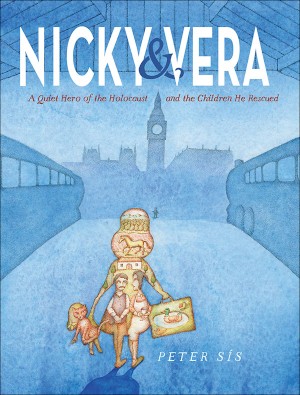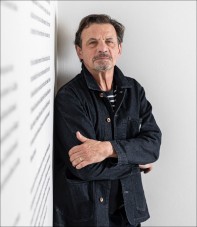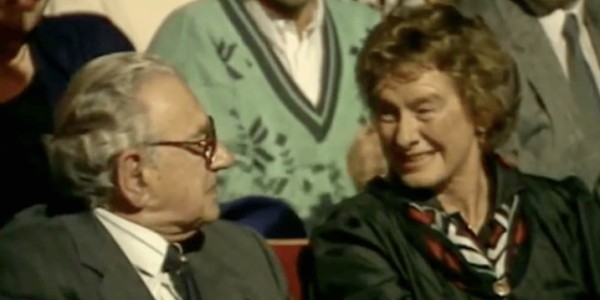'Nicky & Vera: A Quiet Hero of the Holocaust and the Children He Rescued' by Peter Sís
Sep 24, 2020On a trip to his native Prague in 2009, Caldecott Honor artist Peter Sís and his son Matej stumbled upon a celebration in the National Museum, with crowds of visitors and an enormous cake. Sís and his son had just been talking about heroes, and this was a party to honor a hero they had never heard about. Just before the start of World War II, Nicholas Winton coordinated the transport of hundreds of mostly Jewish children from Prague to London. Winton was still alive in 2009, and a commemorative train was about to depart for London, where he would meet the train and some of the children, now all middle-aged adults.As remarkable as Winton’s wartime achievement was, it was followed by something even more remarkable. He went home, packed his papers away in an attic, and never said another word about it—not even to his wife. Nicky & Vera: A Quiet Hero of the Holocaust and the Children He Rescued tells the story of Winton and the children he saved. In a PW exclusive, the cover of Sís’s new book, due out next January from Norton Young Readers, is revealed here for the first time.Nicky & Vera alternates between the story of Nicholas Winton and the story of Vera Gissing, one of the children Winton rescued. Delicate, silvery spreads show Winton as a student, then as a young stockbroker on his way to a skiing holiday when a friend called him to Prague. The Germans were marching into Czechoslovakia. Winton knew that the British government would admit refugee children traveling alone as long as families were willing to sponsor them and a bond was posted for their return.Vera was the daughter of a Jewish couple who lived in the countryside outside of Prague, a girl whose idyllic childhood was shattered the day an invading Nazi officer commandeered her father’s office and spat in his face. Her mother arranged for Vera to travel to London on one of Winton’s trains. It is Vera who is pictured on the book’s cover, a small girl standing alone in the chilly expanse of Liverpool Street Station. Sís’s image of Vera is a beacon of warmth. “Inside her outline are all these brightly colored images of her childhood,” said Simon Boughton, Sís’s editor, and director of the Norton Young Readers imprint, “and she’s waiting there for her new life.”“How do you do the story?” Sís recalled asking himself. “Winton is so quiet and goes into hiding after the war. And then I read Vera Gissing’s beautiful book Pearls of Childhood. She wasn’t a city kid. She lived in a village. She describes the beautiful rivers and trees, searching for mushrooms, riding in her father’s horse and cart through the countryside.”“The earlier versions had more Vera than Nicholas, and Nicholas was kind of in the background,” said Boughton. “It’s something that’s part of the moral fabric of the story, that this man, Nicholas Winton, said very little about his actions. Really, it’s impossible to find him, to quote him, whereas Vera has a lot to say. I love the contrast between the voices. One of the things Peter worked on was to get the two stories to talk, to balance each other, and I think it comes out beautifully in the finished book.”“Winton didn’t speak about what he had done for 50 years,” Sís said. “And then his wife finds the documents in the attic. She asks him about them: ‘There are some documents here.’ And he says, ‘Just throw them out.’ ‘You can’t throw them out,’ she says, ‘they are children’s lives.’ ” Working with journalists, Winton’s wife uncovered more about her husband’s work and the children’s fates, an expedition that culminated in a BBC television show that reunited Winton with many of the children he saved, immortalized in a much-viewed video clip. At long last, Winton’s heroic work was acknowledged as the public learned how, in just a few short weeks, he and his friends had arranged for train travel, interviewed the children’s parents, located hundreds of foster families, obtained visas for the refugees, and, in desperation, forged papers when the bureaucracy failed to issue them. In the BBC clip, Vera Gissing can be seen sitting next to Winton; the two greet each other in a teary reunion. Winton died in 2015, at age 106. Gissing is 92.Eight trains with 669 children aboard made it out of Prague. “He did something spectacular. He didn’t have to do it,” Sís said. “He thought it was the right thing to do, and once it was done he didn’t speak about it. My initial consideration was to find this man who did something and didn’t talk about it, and to tell the consequences. I couldn’t tell everything. I left out the horrors of the war.” On the day the ninth train was scheduled to leave, the German army invaded Poland. The train never left Prague. Of the 250 children who were scheduled to be on it, only two survived. It was perhaps the sadness of knowing there were more he could have saved that contributed to Winton’s long silence.“There aren’t as many books for younger readers that relate to the Holocaust,” Boughton said. “My experience is that there’s an audience for younger material, younger than the Anne Frank level. Like all Peter’s work, the book casts a wide net—it introduces this story, and does it in such a positive way.”As Boughton and Sís worked on the book together earlier this year, they found themselves hamstrung by the pandemic and the resulting lockdown in New York. “I already cannot see my friends or go to the bookstore,” Sís recalled. “I’m missing that contact, touching, feeling, smelling, all the senses! It was very hard to do it long distance. It was difficult even to send things. Once Simon drove [to my house] and was standing outside next to his car. I would stand the portfolio on the side of the car and then run away.”One winter afternoon before the lockdown, however, Sís had a rare opportunity. “It’s a miracle with this book that I finished the art just before Covid. I decided to bring it to the publishing house myself. In the old days you would spread out your art. Now you send a CD. But Norton has this amazing conference room. I put all the pictures on the table, and people would dribble in to look at the art. It’s my first book with them, and their first children’s imprint, and it was such a blessing! Like the old days. It did my heart good.”“I was in the U.K. at Christmas and I went to see the William Blake show at the Tate,” Boughton said. “It’s beautiful, I love Blake, and I was thinking about Peter’s imagination and how it’s sort of like that. Blake has created an entire universe and you get to peek into it through these tiny details, and there’s something about Peter’s work that reminded me of that—these portals into his world, drawn like windows. I think this story surprised him in a certain kind of way. It touched him in a way that’s different from his other books.”“This is really a story about people who are leaving home,” Sís said. “We all leave home. And we realize that we can never go back to the same home we left as a child. And it’s also about someone who is a reluctant hero, a reluctant rescuer. We’re all trying to pay tribute to this man—this generous, quiet, wonderful man.”Nicky & Vera: A Quiet Hero of the Holocaust and the Children He Rescued by Peter Sís. W. W. Norton, $19.95 Jan. 2021 ISBN 978-1-324-01574-1
Tuesday, January 26, 2021
Peter Sís.
Subscribe to:
Post Comments (Atom)







No comments:
Post a Comment